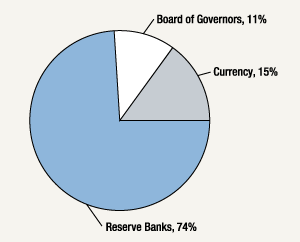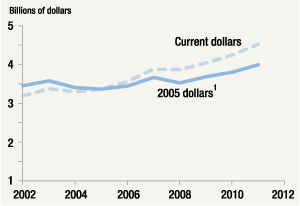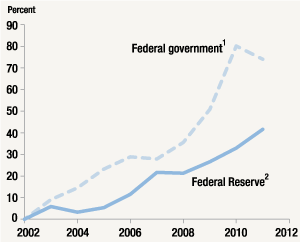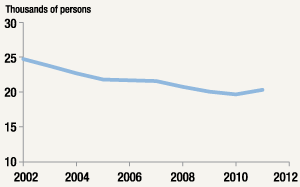Federal Reserve System Budget
Total expenses for the Federal Reserve System for 2011 are budgeted at $4,520.9 million, an increase of 6.5 percent from 2010 actual expenses. Of this total, $3,351.2 million is for the Reserve Banks, $493.6 million is for the Board and the Office of Inspector General (OIG), and $676.1 million is for the cost of new currency (table 2 and table 3). Revenue from priced services provided to depository institutions is expected to total $497.2 million, or 11 percent of total budgeted expenses. This revenue, combined with claims for reimbursement and other income, results in the recovery of approximately 22 percent of the System's budgeted 2011 expenses.5 When these items are deducted from budgeted 2011 expenses, net expenses for the System are 9.9 percent higher than 2010 net expenses (table 2).
| Item | 2009 (actual) | 2010 (actual) | 2011 (budgeted) | Percent change | |
|---|---|---|---|---|---|
| 2009 to 2010 | 2010 to 2011 | ||||
| Total System expenses1 | 4,041.4 | 4,243.3 | 4,520.9 | 5.0 | 6.5 |
| Less | |||||
| Revenue from priced services | 675.4 | 574.7 | 497.2 | -14.9 | -13.5 |
| Claims for reimbursement2 | 450.3 | 456.4 | 492.2 | 1.4 | 7.8 |
| Other income | 1.3 | 1.5 | 1.7 | 12.6 | 14.5 |
| Equals | |||||
| Net System expenses | 2,914.4 | 3,210.8 | 3,529.9 | 10.2 | 9.9 |
Note: Components may not sum to totals and may not yield percentages shown because of rounding. Total expenses reflect all redistributions for support and overhead and exclude capital outlays.
1. Includes extraordinary items and expenses of the Office of Inspector General. Return to table
2. Costs of fiscal agency and depository services provided to the U.S. Treasury, other government agencies, and other fiscal principals that are billed to these agencies. Return to table
| Item | 2009 (actual) | 2010 (actual) | 2011 (budgeted) | Percent change | |
|---|---|---|---|---|---|
| 2009 to 2010 | 2010 to 2011 | ||||
| Reserve Banks 1 | 3,142.5 | 3,183.0 | 3,351.2 | 1.3 | 5.3 |
| Personnel | 2,155.7 | 2,211.8 | 2,371.7 | 2.6 | 7.2 |
| Nonpersonnel | 986.9 | 971.2 | 979.5 | -1.6 | 0.8 |
| Board of Governors 2 | 396.8 | 437.4 | 493.6 | 10.2 | 12.8 |
| Personnel | 294.1 | 325.0 | 360.1 | 10.5 | 10.8 |
| Nonpersonnel | 102.7 | 112.4 | 133.5 | 9.4 | 18.8 |
| Currency 3 | 502.1 | 622.9 | 676.1 | 24.1 | 8.6 |
| Total System expenses | 4,041.4 | 4,243.3 | 4,520.9 | 5.0 | 6.5 |
Note: Expenses exclude capital outlays. Components may not sum to totals and may not yield percentages shown because of rounding.
1. For detailed information on Reserve Bank expenses, see the "Federal Reserve Bank Budgets" section. Return to table
2. Includes extraordinary items and expenses of the Office of Inspector General. See also the "Board of Governors Budgets" section. Return to table
3. For more information on currency expenses, see the "Currency Budget" section. Return to table

The distribution of budgeted expenses is similar to that in previous years, with the Reserve Banks' expenses accounting for 74 percent of the total, new currency expenses accounting for 15 percent, and Board expenses accounting for the remainder (figure 1).
System employment is budgeted at 20,310 for 2011, an increase of 641 from the 2010 level, primarily due to planned staff additions needed to implement new requirements under the Dodd-Frank Act.6
2011 System Budget Initiatives
The Reserve Bank budgets are funding increases in the central bank functions, specifically supervision and regulation and the open market operation in New York, offset by the continued reductions in check operations. The major factors affecting the 2011 Reserve Bank budgets are outlined in more detail in the "Federal Reserve Bank Budgets" section of this report.
Trends in Expenses and Employment
From the actual 2002 level to the budgeted 2011 amount, the total expenses of the Federal Reserve System have increased an average of 4.0 percent per year (1.6 percent per year when adjusted for inflation) (figure 2). Over the same period, nondefense discretionary spending by the federal government has increased an average of 6.3 percent per year (figure 3). Over the 2002-2011 period, Federal Reserve System employment has decreased 4,410 (figure 4).

Accessible Version | Return to text
Note: For 2011, budgeted. Includes extraordinary items and expenses of the Office of Inspector General.
1 Calculated with the GDP price deflator.

Accessible Version | Return to text
Note: For 2011, budgeted.
1 Discretionary spending less expenditures on defense. Source: Budget of the United States Government, Fiscal Year 2011: Historical Tables, Table 8.1. Outlays by Budget Enforcement Act Category, 1962-2015.
2 Includes extraordinary items and expenses of the Office of Inspector General.

Accessible Version | Return to text
Note: For 2011, budgeted. Employment numbers presented include position counts for the Board and average number of personnel (ANP) for the Reserve Banks.
While the most recent budget year reflects the planned increases for resources to address requirements under the Dodd-Frank Act, prior years reflect spending restraint and substantial staffing decreases due to restructuring efforts in the check processing function and efficiency measures in the support and overhead functions. Over the same 10-year period, check costs decreased an average of 13.2 percent annually, and check staff declined an average of 20.9 percent annually. Local support and overhead costs increased an average of 2.2 percent annually and the associated staffing level declined an average of 2.9 percent annually over the same 10-year period.
2011 Capital Budgets
The capital budgets for the Reserve Banks and the Board total $442.9 million, with $417.6 million budgeted for the Reserve Banks, Federal Reserve Information Technology, and Office of Employee Benefits and $25.2 million budgeted for the Board and the OIG. As in previous years, the 2011 capital budgets include funding for projects that support the strategic direction outlined by the individual Reserve Banks, System business leaders, and the Board. These strategic goals focus on investments that continue to improve operational efficiencies, enhance services to bank customers, and ensure a safe and productive work environment. More detailed discussions of the Board and Reserve Bank capital budgets are included in the "Board of Governors Budgets" and "Federal Reserve Bank Budgets" sections.
5. Claims for reimbursement refers to costs of fiscal agency and depository services provided to the U.S. Treasury, other government agencies, and other fiscal principals that are billed to these agencies. Other income comes from services provided on behalf of the U.S. Treasury that are paid for by the depository institutions using the services, which include the transfer of funds between depository institutions and the Treasury. Return to text
6. Employment numbers stated include position counts for the Board and average number of personnel (ANP) for the Reserve Banks. Return to text


